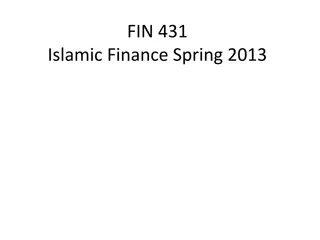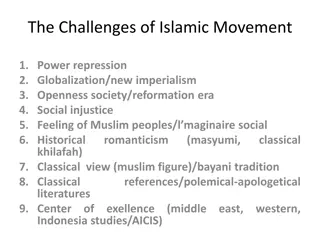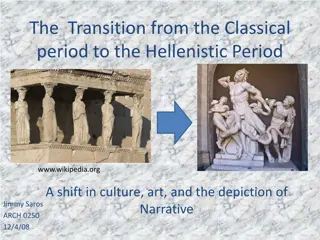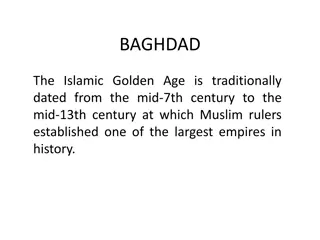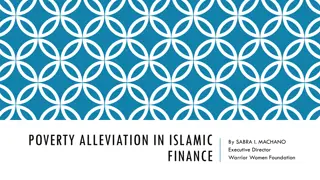The Art of the Abbasid Period: A Golden Age of Islamic Culture
The Abbasid Dynasty (750-1258 A.D.) marked a golden age in Islamic history, with Baghdad and Samarra as key cultural centers. This era saw the emergence of a distinctive art and architecture style characterized by arabesque designs, mosaics, aniconism, calligraphy, and beveled motifs. These features spread across Muslim lands, influencing Islamic art profoundly.
Download Presentation

Please find below an Image/Link to download the presentation.
The content on the website is provided AS IS for your information and personal use only. It may not be sold, licensed, or shared on other websites without obtaining consent from the author. Download presentation by click this link. If you encounter any issues during the download, it is possible that the publisher has removed the file from their server.
E N D
Presentation Transcript
THE ART OF THE ART OF THE ABBASID PERIOD ABBASID PERIOD THE
INTRODUCTION The Abbasid Dynasty existed between the years 750 and 1258 A.D., lasting for more than 500 years. It was the focal point of all Islamic political and cultural life. The Abbasid Dynasty saw a golden age in which Baghdad and Samarra functioned as the cultural and commercial capitals of the Islamic world. It was during this period that a beautiful and distinctive style of art and architecture emerged that spread throughout Muslim lands.
Under the Abbasid caliphate (7501258), which succeeded the Umayyads (661750) in 750, the focal point of Islamic political and cultural life shifted eastward from Syria to Iraq, where, in 762, Baghdad, the circular City of Peace (madinat al-salam), was founded as the new capital. The Abbasids later also established another city north of Baghdad, called Samarra (an abbreviation of the sentence He who sees it rejoices ), which replaced the capital for a brief period (836 92). The first three centuries of Abbasid rule were a golden age in which Baghdad and Samarra functioned as the cultural and commercial capitals of the Islamic world. During this period, a distinctive style emerged and new techniques were developed that spread throughout the Muslim realm and greatly influenced Islamic art and architecture.
Characteristics Arabesque: A repetitive, stylized pattern based on a geometrical floral or vegetal design. Abbasid art is characterized by its arabesque designs. The designs were geometric and repetitive, featuring swirls, lines, and shapes. The style originated in wall carvings in mosques, houses and palaces. Mosaics : The most famous mosaics works are notable for being some of the oldest examples of Islamic arts. Aniconism : By an large rejecting the practice of depicting humans and animals , aniconism is the most notable feature of Muslim art. Calligraphy : Calligraphy is decorated an symbolic because it connects to the idea of transmitting gods what to the people . Also prominent is foliate or vegetal imagery , in which leaves , vines or other plants are rendered in decorative ways. Beveled Style :
Aniconism By an large rejecting the practice of depicting humans and animals , aniconism is the most notable feature of Muslim art.
Arabesque A repetitive, stylized pattern based on a geometrical floral or vegetal design. Abbasid art is characterized by its arabesque designs. The designs were geometric and repetitive, featuring swirls, lines, and shapes. The style originated in wall carvings in mosques, houses and palaces.
Mosaic The most famous mosaics works are notable for being some of the oldest examples of Islamic arts.
Calligraphy Calligraphy is decorated an symbolic because it connects to the idea of transmitting gods what to the people . Also prominent is foliate or vegetal imagery , in which leaves , vines or other plants are rendered in decorative ways.
Beveled Style Working in various materials in this period developed a new aesthetic of swirling patterns .
As the arabesque design flourished, it spread to other sources of artwork, such as wood, metal and pottery, and was no longer limited to wall carvings, but rather was created with paint, ink, and wood carvings. Use of Colour Color became an important factor in Abbasid pottery produced in Samarra. Pottery was glazed in white and then painted over with luster, making the pottery gold and silver in color, which resembled precious metals. Because of its sheen, lusterware looked expensive and quickly became popular and sought after.
Use of Colour
Use of Colour
The Umayyad dynasty produced little of what we would consider decorative arts (like pottery, glass, metalwork), but under the Abbasid dynasty production of decorative stone, wood and ceramic objects flourished. Artisans in Samarra developed a new method for carving surfaces that allowed for curved, vegetal forms (called arabesques) which became widely adopted. There were also developments in ceramic decoration. The use of lustre painting (which gives ceramic ware a metallic sheen) became popular in surrounding regions and was extensively used on tile for centuries. Overall, the Abbasid epoch was an important transitional period that disseminated styles and techniques to distant Islamic lands.
Al Ukhaidhir Fortrees in Karbala
Ibn Tulun Mosque
Minaret in Baghdad
Influence Abbasid art influenced the Umayyad rulers in Spain, who adopted arabesque designs in their architecture. Byzantine envoys traveling to Baghdad returned to Constantinople with reports of beautiful mosques, and the Byzantines thus emulated Abbasid artistic styles in their palaces. Small-scale decorative arts were influential too, most likely because of their portability; lusterware ceramics and glassware were traded and thus influenced artistic practices as far as Egypt, Iran, and Spain. It is postulated that the ceramic transported to Spain influenced ceramic production in the Western world.
DECLINE Political unrest caused a decline in art production, as motivations had to be focused elsewhere. A brief revival of Abbasid art emerged between 1180 and 1233, but it ultimately waned again because of political strife. When the Abbasid era ended, the golden age of art production was finished.


![❤[READ]❤ Robotic Exploration of the Solar System: Part I: The Golden Age 1957-19](/thumb/21623/read-robotic-exploration-of-the-solar-system-part-i-the-golden-age-1957-19.jpg)












